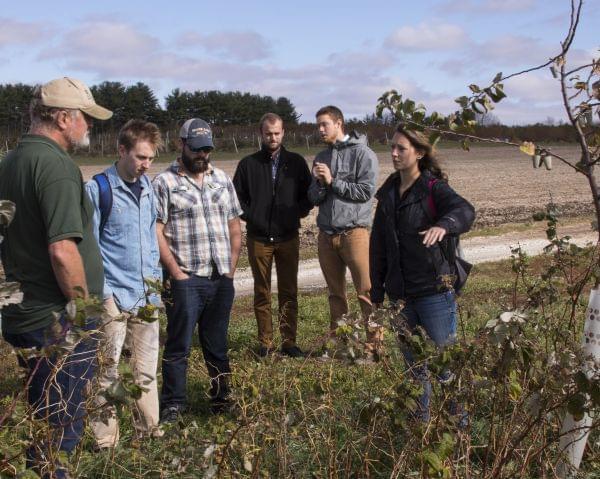Restoration agriculture as a path to land health

Mark Shepard touring the UI Woody Perennial Polyculture research site with, from left, Thomas Poole, Eric Wolske, Andrew Rehn, and Chloe Mattia. Rob Kanter
Prior to the release of his book Restoration Agriculture in early 2013, Wisconsin farmer Mark Shepard’s agent reassured him: “You’ll tour and do some signings for five or six months, but after that sales will taper off and demands on your time will be negligible.” That’s not how things have turned out. Instead, sales of the book have increased from one quarter to the next. Now, Shepard jokes, he may wind up on television talk shows if it moves up another spot on the Amazon list of bestsellers in its category.
Shepard is an energetic, optimistic person who rejects the tendency of our culture to define people and work in ever narrower terms. He was in Champaign recently to speak at the annual dinner of Prairie Rivers Network, the locally-based not-for-profit that champions “clean, healthy rivers and lakes and safe drinking water to benefit the people and wildlife of Illinois.”
Why would Prairie Rivers Network invite a farmer to speak at its dinner? Because he’s one whose work is directed to what Aldo Leopold called “the oldest task in human history: to live on a piece of land without spoiling it.” To that work, it should be noted, Shepard also brings training in mechanical engineering and ecology.
Shepard uses the phrase “restoration agriculture” to describe the suite of practices he has developed over the past twenty years at New Forest Farm, which is situated about 80 miles west of Madison, on 106 acres of land that was considered worthless when he bought it.
There, he has pioneered farming that produces food and fuel for people at the same time it restores ecological integrity to the land by cultivating crops in a system that mimics nature.
What distinguishes restoration agriculture from the systems that currently dominate the landscape of the Midwest? It does away with crops like corn and soybeans that must be planted annually and that rely heavily on inputs of synthetic fertilizers and pesticides, and replaces them with a diverse mix of nuts, fruits, and forage. In addition, restoration agriculture incorporates livestock into the crop system.
So, where a conventional field is covered in a single horizon of corn or beans for half the year and bare the rest, a restoration agriculture site is covered with perennials. It might include an overstory row of chestnut, with a mid-layer of apple trees, with hazelnuts and currants below that, and an alley of pasture to separate one row from the next
The idea is to create a system in which nature takes care of work—and costs—that in annual systems are shifted elsewhere. Think of the costs associated with ammonia fertilizer, for example, which begin with the extraction of the natural gas needed to make it, include the money the farmer spends to buy it, and then the pollution created as some of it runs into waterways. In contrast, the manure produced by Shepard’s cattle isn’t a problem for him to get rid of, it’s fertilizer he doesn’t have to buy.
As animated as Shepard was sharing stories of his own work in Wisconsin, he was even more excited to call people’s attention to similar efforts taking root in central Illinois. These include the Woody Perennial Polyculture research site at the UI (which I profiled here in July 2014) and the Savanna Institute, an associated non-profit organization. I’ve got both of them on my list of future stories.

